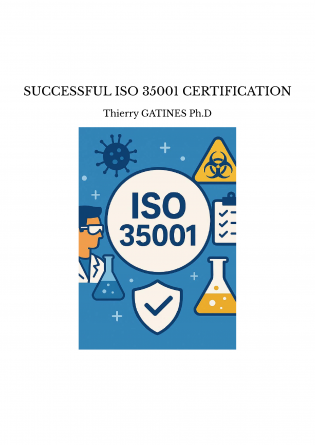ISO 35001 successful certification: the global standard for biosafety and biosecurity management
In a world where biological risks can impact public health, research integrity, and environmental safety, the ISO 35001 standard sets the international benchmark for biosafety and biosecurity management.
It provides laboratories and research centres with a structured framework to identify, assess, and control biological risks effectively.
The book ISO 35001 Successful Certification serves as a comprehensive and practical guide, supporting organisations step by step on their journey towards certification and sustainable biosafety culture.
Why ISO 35001 is essential for laboratories and research centres
Laboratories working with pathogens or biological materials face multiple challenges, including risk containment, regulatory compliance, and staff protection.
To address these challenges, ISO 35001 offers a management system inspired by ISO 9001, but specifically adapted to biosafety and biosecurity.
It establishes clear requirements for risk assessment, preventive controls, and emergency preparedness.
Moreover, it promotes a proactive approach, ensuring that biosafety measures are integrated into every stage of laboratory operations.
By adopting this standard, organisations can strengthen safety, reduce incidents, and build trust with regulatory authorities and research partners.
As a result, ISO 35001 Successful Certification becomes a strategic reference, helping laboratories turn compliance into a culture of safety and excellence.
A step-by-step guide to achieving ISO 35001 certification
The book provides a clear and practical roadmap for implementing ISO 35001 within laboratory and research environments.
Each chapter explains a specific phase of the certification journey, supported by examples, tools, and expert insights.
The key steps include:
-
Risk identification: recognise and classify biological hazards associated with activities and materials.
-
Risk assessment: evaluate likelihood and potential impact to prioritise preventive actions.
-
Risk control: implement engineering, procedural, and personal protection measures.
-
System implementation: integrate biosafety objectives into the organisation’s management system.
-
Audit preparation: perform internal evaluations, document compliance, and get ready for external review.
Thanks to this structured method, the guide helps organisations build a compliant biosafety management system and achieve certification efficiently.
In addition, it fosters continuous improvement, ensuring safety measures evolve with emerging biological risks.
Practical tools and real-world case studies for implementation
To make implementation easier, ISO 35001 Successful Certification includes a variety of practical resources, such as risk assessment matrices, checklists, procedural templates, and training guides.
Each chapter features real-world case studies, showing how laboratories and research centres have successfully applied ISO 35001 principles.
These examples illustrate best practices, common challenges, and solutions to strengthen biosafety culture.
Furthermore, the guide provides performance indicators and self-assessment tools for tracking progress and maintaining compliance over time.
As a result, it functions not only as a reference guide but also as an operational manual, helping organisations turn theory into practical outcomes.
A strategic certification for a sustainable culture of biosafety
Achieving ISO 35001 certification is more than a regulatory requirement — it is a commitment to protecting people, science, and the environment.
Certified organisations demonstrate their ability to manage biological risks, prevent incidents, and respond effectively to emergencies.
Moreover, certification reinforces stakeholder confidence, showing dedication to safe research practices and global health standards.
It also supports staff engagement, as team members work within a structured and secure environment.
Therefore, ISO 35001 Successful Certification stands as a strategic guide, enabling laboratories to transform biosafety obligations into a foundation of trust and scientific excellence.
Fiches techniques

Normes ISO disponibles
par thierry.gatines | Août 11, 2025 | Fiches techniques

Audit ISO les erreurs à éviter
par thierry.gatines | Août 11, 2025 | Fiches techniques

Les étapes clés de la certification ISO
par thierry.gatines | Août 11, 2025 | Fiches techniques

